That's probably true, unless China wants to get involved in Ukraine. However, the use of Russian airspace might be feasible. So you could refuel over RussiaI think the use of Russian bases in a stretch too far.
You are using an out of date browser. It may not display this or other websites correctly.
You should upgrade or use an alternative browser.
You should upgrade or use an alternative browser.
PLA Strategy in a Taiwan Contingency
- Thread starter pugachev_diver
- Start date
Looks like I need to clarify a bit on this matter.That's probably true, unless China wants to get involved in Ukraine. However, the use of Russian airspace might be feasible. So you could refuel over Russia
First-and-foremost - If there is already an all-out Pacific War 2.0 between China and the US&LC, it is highly likely that Russia would have been playing the role of (at the very least) an active non-belligerent in the conflict, preferably on China's side.
Without Russia's (direct or indirect) involvement, the H-20s would be forced to travel for much greater distances in order to conduct strike missions against Oahu and Anchorage, let alone western CONUS.
Whether China will/should get involved in the current war in Ukraine in order to gain access to Russian airbases in the Russian Far East is not considered to be part of the discussion.
Next, regarding the usage of Russian airbases for the H-20 to refuel in their expeditionary strike missions in the EastPac - TBH, that isn't really a decisive point. In fact, any usage of Russian airbases by the PLAAF is much more vital for the YY-20A/Bs than the H-20s.
This is mainly because just like any aircraft across the world that carries any kind of payload onboard - The viable payload capacity always decreases with range. It is a physical impossibility for any aircraft to carry the maximum amount of payload onboard - And still be able to fly for the maximum possible range designed for the aircraft itself.
With this in mind, let's assume (the usual) that:
1. The H-20 is broadly similar to the B-2 Spirit, and
2. The YY-20A/B is broadly similar to the Il-78M.
Here are some information for due digest:
1. The officially-listed fuel capacity of the B-2 is ~167000 pounds, or ~75.6 tons;
2. The maximum transferrable fuel load of Il-78M based on range:
2a. ~74 tons at 1000 kilometers;
2b. ~56 tons at 2000 kilometers; and
2c. ~40 tons at 3000 kilometers - Plus
3. The distance between Changchun and Oahu is ~7500 kilometers, with routes set to fly near the southern end of Kamchatka in order to deviate around Hokkaido for as reasonably far as possible -
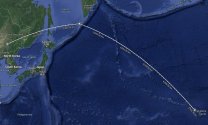
And because China (and Russia) does not possess airbases anywhere beyond their territorial borders, therefore any refueling missions for the H-20 must be conducted within reach of Chinese (and/or Russian) airbases where the YY-20s are based in - With the added requirement that the H-20s can be sufficiently and meaningfully refueled in order to allow them to continue their expeditionary strike missions in the EastPac, and/or being able to return to their home/front bases in China.
Here's the 1000-kilometer range from Jiamusi Airport (Heliongjiang, China), which has most probably the northeastern-most runway in China that can handle a YY-20:
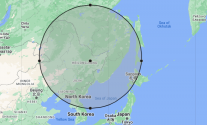
Here's the 1000-kilometer range from Yuzhno-Sakhalin (Sakhalin, Russia):
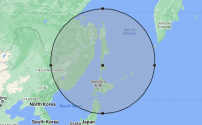
And lastly, here's the 1000-kilometer range from Petropavlovsk-Kamchatsky (Kamchatka, Russia):
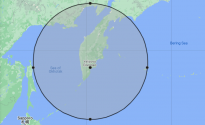
As we can see, the 1000-kilometer range refueling circles can essentially cover the refueling mission of the H-20s conducting expeditionary strike missions in the EastPac meaningfully, with the maximum extend being the western end of the Aleutian Islands.
Needless to say, the further out the refueling circle is located relative to the home/forward airbases of the H-20s in China, the better the prospects of the H-20s to be refueled mid-air without having to consume the majority of its fuel load onboard beforehand. This also reduces the risk of said H-20s running close to/running out of fuel when conducting such expeditionary strikes deep into the Pacific.
Of course, the YY-20s can takeoff from bases in Heilongjiang and travel all the way to a distance of ~2000 kilometers (i.e. over the Sea of Okhotsk/northern Kuril Islands) in order to conduct mid-air refueling of the H-20s, but the amount of transferrable fuel from the YY-20s to the H-20s would have been drastically reduced.
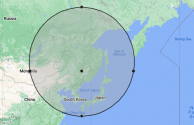
Therefore, I do believe that in case of Pacific War 2.0, access to Russian air bases capable of supporting YY-20s must be secured in order to permit expeditionary strike missions by the H-20 in the EastPac - Perhaps even the western CONUS - To be realized.
Last edited:
Hypothetically asking, would an H-20 attack on Alaskan NORAD sites and Elmendorf AFB not be both logistically simpler and more politically threatening, if not quite as relevant to actions in the Taiwan theater?Looks like I need to clarify a bit on this matter.
First-and-foremost - If there is already an all-out Pacific War 2.0 between China and the US&LC, it is highly likely that Russia would have been playing the role of (at the very least) an active non-belligerent in the conflict, preferably on China's side.
Without Russia's (direct or indirect) involvement, the H-20s would be forced to travel for much greater distances in order to conduct strike missions against Oahu and Anchorage, let alone western CONUS.
Whether China will/should get involved in the current war in Ukraine in order to gain access to Russian airbases in the Russian Far East is not considered to be part of the discussion.
Next, regarding the usage of Russian airbases for the H-20 to refuel in their expeditionary strike missions in the EastPac - TBH, that isn't really a decisive point. In fact, any usage of Russian airbases by the PLAAF is much more vital for the YY-20A/Bs than the H-20s.
This is mainly because just like any aircraft across the world that carries any kind of payload onboard - The viable payload capacity always decreases with range. It is a physical impossibility for any aircraft to carry the maximum amount of payload onboard - And still be able to fly for the maximum possible range designed for the aircraft itself.
With this in mind, let's assume (the usual) that:
1. The H-20 is broadly similar to the B-2 Spirit, and
2. The YY-20A/B is broadly similar to the Il-78M.
Here are some information for due digest:
1. The officially-listed fuel capacity of the B-2 is ~167000 pounds, or ~75.6 tons;
2. The maximum transferrable fuel load of Il-78M based on range:
2a. ~74 tons at 1000 kilometers;
2b. ~56 tons at 2000 kilometers; and
2c. ~40 tons at 3000 kilometers - Plus
3. The distance between Changchun and Oahu is ~7500 kilometers, with routes set to fly near the southern end of Kamchatka in order to deviate around Hokkaido for as reasonably far as possible -
View attachment 117186
And because China (and Russia) does not possess airbases anywhere beyond their territorial borders, therefore any refueling missions for the H-20 must be conducted within reach of Chinese (and/or Russian) airbases where the YY-20s are based in - With the added requirement that the H-20s can be sufficiently and mikkkmeaningfully refueled in order to allow them to continue their expeditionary strike missions in the EastPac, and/or being able to return to their home/front bases in China.
Here's the 1000-kilometer range from Jiamusi Airport (Heliongjiang, China), which has most probably the northeastern-most runway in China that can handle a YY-20:
View attachment 117182
Here's the 1000-kilometer range from Yuzhno-Sakhalin (Sakhalin, Russia):
View attachment 117183
And lastly, here's the 1000-kilometer range from Petropavlovsk-Kamchatsky (Kamchatka, Russia):
View attachment 117184
As we can see, the 1000-kilometer range refueling circles can essentially cover the refueling mission of the H-20s conducting expeditionary strike missions in the EastPac meaningfully, with the maximum extend being the western end of the Aleutian Islands.
Needless to say, the further out the refueling circle is located relative to the home/forward airbases of the H-20s in China, the better the prospects of the H-20s to be refueled mid-air without having to consume the majority of its fuel load onboard beforehand. This also reduces the risk of said H-20s running close to/running out of fuel when conducting such expeditionary strikes deep into the Pacific.
Of course, the YY-20s can takeoff from bases in Heilongjiang and travel all the way to a distance of ~2000 kilometers (i.e. over the Sea of Okhotsk/northern Kuril Islands) in order to conduct mid-air refueling of the H-20s, but the amount of transferrable fuel from the YY-20s to the H-20s would have been drastically reduced.
View attachment 117206
Therefore, I do believe that in case of Pacific War 2.0, access to Russian air bases capable of supporting YY-20s must be secured in order to permit expeditionary strike missions by the H-20 in the EastPac - Perhaps even the western CONUS - To be realized.
Last edited:
FriedRiceNSpice
Major
Not sure if you want to be directly attacking NORAD sites...Hypothetically asking, would an H-20 attack on Alaskan NORAD sites and Elmendorf AFB not be both logistically simpler and more politically threatening, if not quite as relevant to actions in the Taiwan theater?
Oh, I’m sorry; I didn’t know that China’s leadership had to ask permission from Anglo-apologists when targeting retaliating for attacks on the Chinese mainland!Not sure if you want to be directly attacking NORAD sites...
There's plenty of other targets than NORAD, not to mention the elavated risk of nuclear weapon usage if such a site is attacked (retaliation against NORAD incase of the US targeting sites with similar purpose is like, duh, ofc, but if not).Oh, I’m sorry; I didn’t know that China’s leadership had to ask permission from Anglo-apologists when targeting retaliating for attacks on the Chinese mainland!
D
Deleted member 24525
Guest
NORAD is responsible for nuclear early-warning surveillance. Attacking it would be interpreted as the prelude to a first strike.Oh, I’m sorry; I didn’t know that China’s leadership had to ask permission from Anglo-apologists when targeting retaliating for attacks on the Chinese mainland!
So, in other words, the U. S. can attack whichever targets they choose on the Chinese mainland, yet China must defer to U. S. sensitivities when choosing targets for retaliation?There's plenty of other targets than NORAD, not to mention the elavated risk of nuclear weapon usage if such a site is attacked (retaliation against NORAD incase of the US targeting sites with similar purpose is like, duh, ofc, but if not).
Wow, I didn’t recognize China for the 2nd rate sovereign that, this reveals, it must certainly, be!
Guess I’ll get my Taiwan Independence Celebration flags, now; ‘cause, it’s obvious, we all know who’s really runnin’ sh!t, huh!
What is your point?So, in other words, the U. S. can attack whichever targets they choose on the Chinese mainland, yet China must defer to U. S. sensitivities when choosing targets for retaliation?
Wow, I didn’t recognize China for the 2nd rate sovereign that, this reveals, it must certainly, be!
Guess I’ll get my Taiwan Independence Celebration flags, now; ‘cause, it’s obvious, we all know who’s really runnin’ sh!t, huh!
In war you need to use your weapons intelligently. US would also need to ration their weapons for attacks that directly support their forces, not random ones that easily get caught by air defence and wastes valuable supplies which could have been used to help the very beleaguered invasion force under full Chinese attack.
For the same reasons, China would be better served using their firepower to break apart the attacking forces, rather than waste time trying to suppress NORAD installations, when said installations can probably be repaired at a faster rate than China can suppress them across the Pacific, and when such installations doesn't really support the urgent threat to China, which is the invasion force.
Use your brain. China might do a few sporadic PR strikes, but there would be more publicly impactful targets than NORAD, and the overarching focus would be on using most fires to break apart the US assault. After US loses offensive capability, then China can just do whatever they want.
